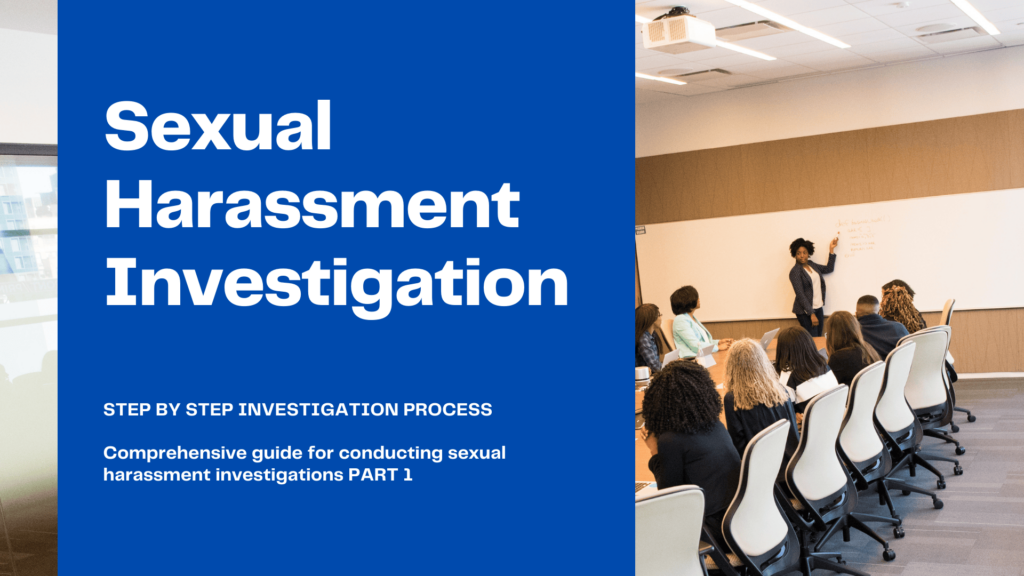The National Survey conducted by the Australian Government Department of Social Services revealed that in the last five years, 39% of women and 26% of men have experienced sexual harassment at work. This confirms that sexual harassment is widespread and pervasive.
According to the U.S. Equal Employment Opportunity Commission (EEOC), sexual harassment includes unwelcome sexual advances, requests for sexual favors, and other verbal or physical harassment of a sexual nature. It also can include offensive remarks about a person’s gender. While in Australia, the Sex Discrimination Act 1984 outlines the circumstances in which sexual harassment occurs.

Sexual harassment is considered illegal in many jurisdictions, and investigators must take sexual and any other form of employee harassment seriously.
Disturbingly, the reporting of workplace sexual harassment continues to be low. According to the Australian Human Rights Commission, only 17% of people who experienced sexual harassment in the workplace in the last five years made a formal complaint. This highlights the importance of employers taking steps to prevent workplace sexual harassment and to ensure that they respond appropriately when a report is made.
In a series of posts, we will help you understand how to better conduct sexual harassment investigations and protect individuals from risk.
This paper will provide:
- Step-by-step investigation guide on Sexual Harassment cases
- Key Documents relevant to sexual harassment investigations
Step-by-step guide for Sexual Harassment Investigations
The investigation can be broken down into the following steps
- Planning
- Interview
- Making a decision
- Writing a Report
Planning
Important questions to ask yourself may be:
- Who will investigate?
- What evidence needs to be collected?
- Who will be interviewed?
To protect the credibility of the process, you may want to select an investigator who is not close to either party. Choosing an objective third party not only provides a stronger defense for the employer if a case ever goes to court, it can also make it easier for business leaders to make the right decision, even if it means terminating someone who is of higher position.
Organisations should also consider hiring an external investigator, depending on the nature of the allegations and those involved. Engaging an external investigator is advantageous to an organisation in:
- maintaining its integrity and reliability, particularly when outcomes are unforeseen; and
- obtaining an outside perspective, experience and impartiality, particularly if those responsible for investigating the matter(s) are close to those involved.
As with bullying or other general harassment investigations, it is important at this point to consider if the allegations are serious enough to warrant suspending the respondent in order to reduce the risk of further harm to the alleged victim and other workers, or to prevent interferance in the investigation. It is important to have clear provisions for suspension in your discipline policy and process.
Interview
This section will help you understand the:
- Interview process
- Credibility assessment
Interview Process
This can be separated into two parts:
- Planning
- Execution
Planning the Interview
- When preparing interview questions, try to write open-ended questions
- You may also ask “Were there witnesses? Did others know you were upset by this? Did you talk to family members or friends?”
- It is best practice to ask 1. Background questions and 2. Specific questions related to the incident
Background Questions
Questions to ask the complainant:
- What kind of work do you do for the company?
- What is your job title?
- How long have you worked for the company?
- Who is your supervisor?
Questions to ask the alleged harasser:
- How do you communicate with your employees or co-workers (memos, meetings, one-on-one, etc.)?
- How would you describe the workplace environment in your department?
- Is the atmosphere pretty relaxed and easy-going?
- How do you assign projects to your employees?
- Does your department work much overtime
- How well do you know the employees in your department?
- Has anything happened lately to disrupt the department’s harmony?
Questions to ask witnesses/third-parties:
- What is the general workplace atmosphere like in the employee’s group
- What style of communication is used by the employee? His or her supervisor
- Other employees?
- What is the supervisor’s managerial style?
- How is important information provided to employees?
- Are there any problems within the department?
- Have co-workers complained about inappropriate behavior in the department?
- Have you personally noticed or been offended by inappropriate behavior?
- Please describe any inappropriate or offensive behavior that you have experienced or witnessed.
- Are there any calendar pictures or posters displayed which offend you or someone else?
- Have offensive jokes or comments been made about people in the department?
- (If the answer to the above question is yes then ask.) Who made these remarks and what was said?
Questions Specific to the Incident
- Who, what, when, where, and how: Who committed the alleged harassment? What exactly occurred or was said? When did it occur and is it still ongoing? Where did it occur? How often did it occur? How did it affect you?
- How did you react? What response did you make when the incident(s) occurred or afterwards?
- How did the harassment affect you? Has your job been affected in any way?
- Are there any other persons who have relevant information? Was anyone present when the alleged harassment occurred? Did you tell anyone about it? Did anyone see you immediately after episodes of alleged harassment?
- Did the person who harassed you harass anyone else? Do you know whether anyone complained about harassment by that person?
- Are there any notes, physical evidence, or other documentation regarding the incident(s)?
- How would you like to see the situation resolved?
- Do you know of any other relevant information?
Questions to ask the alleged harasser:
- What is your response to the allegations?
- What is your recollection of the situation(s) in which the alleged incident occurred?
- If the harasser claims that the allegations are lies, ask what the complainant’s motivation might be for lying.
- Are there any persons who have relevant information?
- Are there any notes, physical evidence, or other documentation regarding the incident(s)?
- Do you know of any other relevant information?
Questions to ask witnesses/third-parties:
- What did you see or hear? When did this occur? Describe the alleged harasser’s behavior toward the complainant and toward others in the workplace.
- What did the complainant tell you? When did s/he tell you this?
- Do you know of any other relevant information?
- Are there other persons who have relevant information?
During the Interview
- Don’t promise confidentiality to any interviewees, but explain that you will do your best to keep the details of the investigation confidential.
- Take statements from interviewees when appropriate. Statements can be valuable evidence that supports or refutes the complainant’s story.
- Ask those you’ve interviewed to keep the conversations confidential.

Credibility Assessment
If there are conflicting versions of relevant events, the employer will have to weigh each party’s credibility. Credibility assessments can be critical in determining whether the alleged harassment in fact occurred. According to the U.S. Equal Employment Opportunity Commission, factors to consider include:
Plausibility
Is the individual’s version of the facts believable? Are there inconsistent statements?
Things to consider:
- Has the story changed prior to or during the investigation?
- Is the person being consistent when telling his or her story?
- Does the accuser’s timing of the alleged events match witnesses’ stories?
- Is this story still logically plausible when all evidence is taken into account?
Language
The nuances of language and the words chosen when answering questions convey a lot more than the literal content of a statement.
Most people have a psychological aversion to lying, and so may shape their answers to deny an allegation without explicitly lying. For example ‘I would never do that’ is a much different answer to ‘I didn’t do that’.
Demeanor
Does the individual appear to be telling the truth? Things to consider include non-verbal cues such as voice tone, facial expressions, body language and other cues such as manner and attitude. However, you must be extremely careful when judging demeanor as it is an unreliable indicator of credibility. Interview situations can make people uncomfortable, and they may be nervous or hostile even when telling the truth.
Motive
Does the individual have a reason to lie?
Things to consider:
- Have they ever lied or fabricated stories to cover for other behaviour?
- Have they ever lied or fabricated stories for personal gain?
Corroboration
Are there documents or other witnesses that support the individual’s version of events?
Things to consider:
- Can anyone else verify this story?
- Is there any evidence to support the accusations?
- Is there any way the evidence could be falsified or fabricated?
Past records
Do any of the individuals have a prior history of inappropriate conduct or false statements?
Other important questions to ask yourself:
- Are both accounts internally/externally consistent?
- Did the accused have time to do what the victim alleged?
- Does the victim have any possible motive for falsely implicating the accused?
- Could the harassment have happened at the time and location specified?
- Despite the fact that there were no witnesses, could the harassment have taken place at the time and the location?
Making a decision
There are two things to consider during this process:
- Whether a company policy was violated or inappropriate conduct occurred
- Recommended course of action
Whether a company policy was violated or inappropriate conduct occurred:
- Consider all the evidence collected, including interviews, credibility assessments, documentation, etc.
- Make sure you are assessing the situation fairly with the information you have.
- Consult with others to avoid personal bias
- Re-interview witnesses to fill in any gaps in information or to probe further where you think there is more to learn.
Determining the course of action:
- Make work or assignment setting adjustments, or change a reporting assignment if necessary.
- If the allegations are supported, the employer should take immediate and appropriate corrective action, which could range from a written reprimand to termination of employment depending on the severity and frequency of the misconduct
- Even if no determination was made due to inconclusive evidence, the employer should still undertake preventive measures, such as training and monitoring.
Make sure high-position employees such as CEOs are given the same treatment as low-position employees for similar conduct. It’s important to maintain a consistent, procedurally fair process for all employees and all allegations.
Examples of Measures to Stop the Harassment and Ensure that it Does Not Recur:
- Oral/written warning or reprimand;
- transfer or reassignment;
- demotion;
- reduction of wages;
- suspension;
- discharge;
- training or counseling of harasser to ensure that s/he understands why his or her conduct violated the employer’s anti-harassment policy; and
- monitoring of harasser to ensure that harassment stops.
Examples of Measures to Correct the Effects of the Harassment:
- restoration of leave taken because of the harassment;
- expungement of negative evaluation(s) in employee’s personnel file that arose from the harassment;
- reinstatement;
- apology by the harasser;
- monitoring treatment of employee to ensure that s/he is not subjected to retaliation by the harasser or others in the workplace because of the complaint; and
- correction of any other harm caused by the harassment (e.g., compensation for losses).
Writing a Report
Create a written report documenting the investigation process, findings, recommendations and any disciplinary action imposed, as well as any corrective and preventive action. Take a look at our article: 12 Things to Include in an Investigation Report
After you’ve submitted the written report to the decision-maker and determined the appropriate disciplinary action (if any), follow up with both parties. Tell the person who filed the complaint that appropriate action was taken, even if you can’t share the details for privacy reasons.
Check back with that employee regularly to ensure that no further harassment has occurred and that there has been no retaliation, which could trigger additional liability.
Afford the respondent the same courtesy of follow-up and documentation. Adjust working situations fairly where necessary for the comfort and productivity of all.
Key Documents for Sexual Harassment Investigations
Documents are critical during any investigative process. This section will highlight:
- Key documents to collect
- Obtaining other facts and evidence
- Tips for Record Keeping
Key documents
Documents which may be particularly relevant for your sexual harassment investigation may include:
- company code of conduct and related policy documents
- employee files
- copy of the allegation
- past complaints
- past performance valuations
- any supporting documents
Consider whether the person making the allegation might be seeking retribution for a poor evaluation. Also evaluate any past complaints against the person being accused. Contact former employees, particularly the individual who previously held the accuser’s job or anyone in the same department who left suddenly without explanation, to find out if they also had problems with the accused employee.
Other facts and evidence
This may involve interviewing witnesses, and examining evidence such as emails, internet content including social media sites, or camera footage.
Record Keeping
To demonstrate compliance, it is important to maintain records that demonstrate the reasonable steps you have taken to prevent and respond to sexual harassment or suspected sexual harassment in the workplace.
The Polonious Case Management Software ensures your evidence and case files are secure and anonymous, depending on the level of anonymity requested. This is particularly important due to the sensitive nature of sexual harassment investigations.
How Polonious can Help
It is advisable for an employer to keep records of all complaints of harassment. Without such records, the employer could be unaware of a pattern of harassment by the same individual.
The Polonious Case Management Software can provide a consistent process that is procedurally fair for both the complainant and respondent, provides secure evidence management, fully auditable records, and detailed reporting for identifying trends and reporting areas.
Our secure portal and email integration make investigations easy for investigators, as well as ensuring the employee has a chance to respond to allegations and stay informed throughout the investigative process.
Continue to follow us on our future blogs on Tips for Sexual Harassment Investigation. We will outline interview tips, and how to handle various complaint outcomes.
Let's Get Started
Interested in learning more about how Polonious can help?
Get a free consultation or demo with one of our experts




